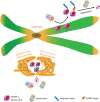Recent insights into mechanisms preventing ectopic centromere formation
- PMID: 34493071
- PMCID: PMC8424319
- DOI: 10.1098/rsob.210189
Recent insights into mechanisms preventing ectopic centromere formation
Abstract
The centromere is a specialized chromosomal structure essential for chromosome segregation. Centromere dysfunction leads to chromosome segregation errors and genome instability. In most eukaryotes, centromere identity is specified epigenetically by CENP-A, a centromere-specific histone H3 variant. CENP-A replaces histone H3 in centromeres, and nucleates the assembly of the kinetochore complex. Mislocalization of CENP-A to non-centromeric regions causes ectopic assembly of CENP-A chromatin, which has a devastating impact on chromosome segregation and has been linked to a variety of human cancers. How non-centromeric regions are protected from CENP-A misincorporation in normal cells is largely unexplored. Here, we review the most recent advances on the mechanisms underlying the prevention of ectopic centromere formation, and discuss the implications in human disease.
Keywords: CENP-A; chromosomes segregation; ectopic centromeres; epigenetics; kinetochore; neocentromere.
Conflict of interest statement
We declare we have no interests to declare.
Figures




Similar articles
-
Mislocalization of centromeric histone H3 variant CENP-A contributes to chromosomal instability (CIN) in human cells.Oncotarget. 2017 Jul 18;8(29):46781-46800. doi: 10.18632/oncotarget.18108. Oncotarget. 2017. PMID: 28596481 Free PMC article.
-
Guarding the Genome: CENP-A-Chromatin in Health and Cancer.Genes (Basel). 2020 Jul 16;11(7):810. doi: 10.3390/genes11070810. Genes (Basel). 2020. PMID: 32708729 Free PMC article. Review.
-
Ectopic centromere nucleation by CENP--a in fission yeast.Genetics. 2014 Dec;198(4):1433-46. doi: 10.1534/genetics.114.171173. Epub 2014 Oct 7. Genetics. 2014. PMID: 25298518 Free PMC article.
-
Targeted De Novo Centromere Formation in Drosophila Reveals Plasticity and Maintenance Potential of CENP-A Chromatin.Dev Cell. 2020 Feb 10;52(3):379-394.e7. doi: 10.1016/j.devcel.2020.01.005. Dev Cell. 2020. PMID: 32049040 Free PMC article.
-
Centromeric and ectopic assembly of CENP-A chromatin in health and cancer: old marks and new tracks.Nucleic Acids Res. 2019 Feb 20;47(3):1051-1069. doi: 10.1093/nar/gky1298. Nucleic Acids Res. 2019. PMID: 30590707 Free PMC article. Review.
Cited by
-
Prenatally detected six duplications at Xp22.33-p11.22: a case report.BMC Pregnancy Childbirth. 2023 Apr 27;23(1):294. doi: 10.1186/s12884-023-05627-0. BMC Pregnancy Childbirth. 2023. PMID: 37106349 Free PMC article.
-
Cell cycle control of kinetochore assembly.Nucleus. 2022 Dec;13(1):208-220. doi: 10.1080/19491034.2022.2115246. Nucleus. 2022. PMID: 36037227 Free PMC article. Review.
-
A dynamic population of prophase CENP-C is required for meiotic chromosome segregation.PLoS Genet. 2023 Nov 29;19(11):e1011066. doi: 10.1371/journal.pgen.1011066. eCollection 2023 Nov. PLoS Genet. 2023. PMID: 38019881 Free PMC article.
-
Humanization reveals pervasive incompatibility of yeast and human kinetochore components.G3 (Bethesda). 2023 Dec 29;14(1):jkad260. doi: 10.1093/g3journal/jkad260. G3 (Bethesda). 2023. PMID: 37962556 Free PMC article.
References
Publication types
MeSH terms
Substances
Grants and funding
LinkOut - more resources
Full Text Sources
Medical

